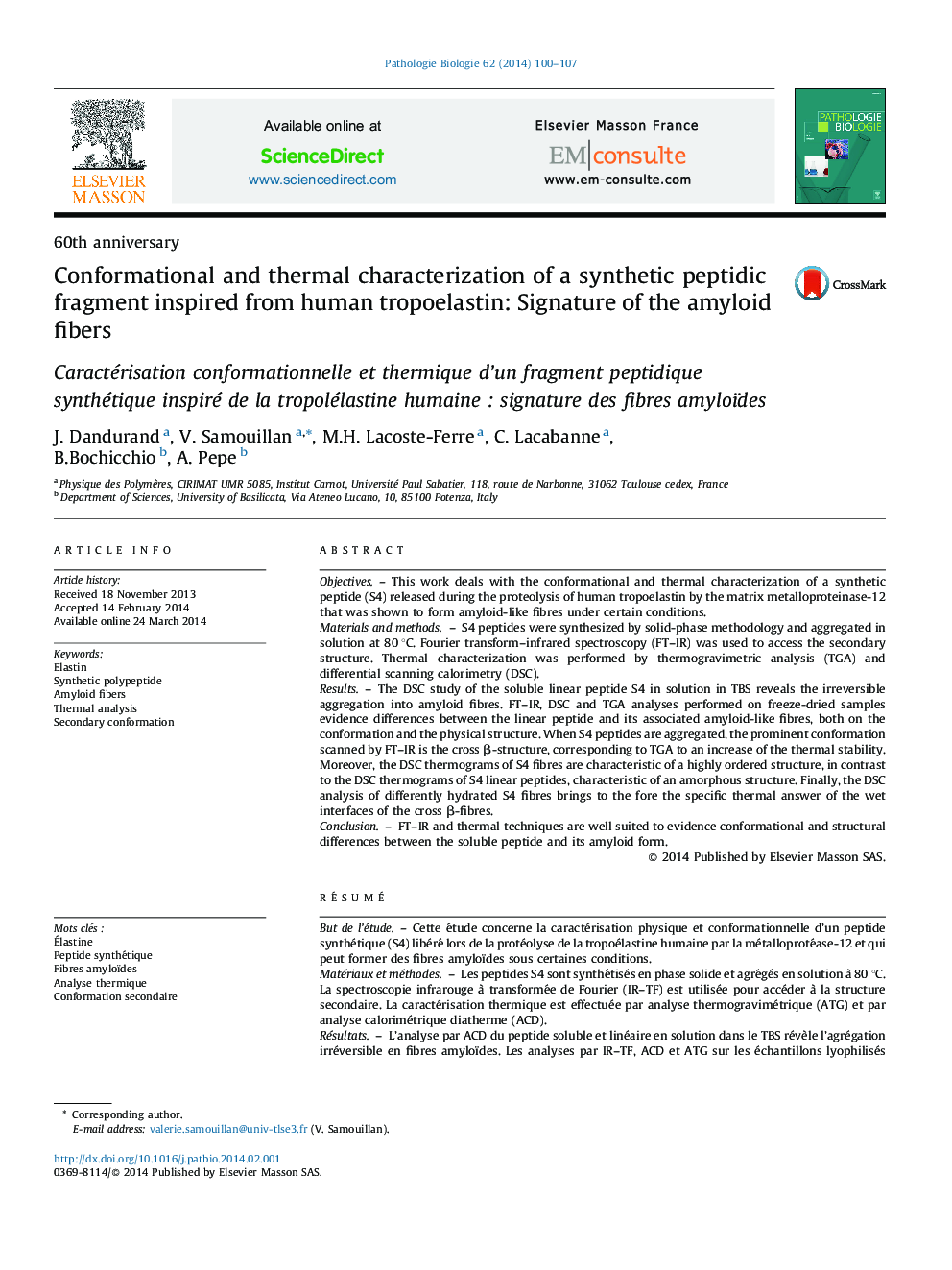| کد مقاله | کد نشریه | سال انتشار | مقاله انگلیسی | نسخه تمام متن |
|---|---|---|---|---|
| 4135948 | 1271885 | 2014 | 8 صفحه PDF | دانلود رایگان |
ObjectivesThis work deals with the conformational and thermal characterization of a synthetic peptide (S4) released during the proteolysis of human tropoelastin by the matrix metalloproteinase-12 that was shown to form amyloid-like fibres under certain conditions.Materials and methodsS4 peptides were synthesized by solid-phase methodology and aggregated in solution at 80 °C. Fourier transform–infrared spectroscopy (FT–IR) was used to access the secondary structure. Thermal characterization was performed by thermogravimetric analysis (TGA) and differential scanning calorimetry (DSC).ResultsThe DSC study of the soluble linear peptide S4 in solution in TBS reveals the irreversible aggregation into amyloid fibres. FT–IR, DSC and TGA analyses performed on freeze-dried samples evidence differences between the linear peptide and its associated amyloid-like fibres, both on the conformation and the physical structure. When S4 peptides are aggregated, the prominent conformation scanned by FT–IR is the cross β-structure, corresponding to TGA to an increase of the thermal stability. Moreover, the DSC thermograms of S4 fibres are characteristic of a highly ordered structure, in contrast to the DSC thermograms of S4 linear peptides, characteristic of an amorphous structure. Finally, the DSC analysis of differently hydrated S4 fibres brings to the fore the specific thermal answer of the wet interfaces of the cross β-fibres.ConclusionFT–IR and thermal techniques are well suited to evidence conformational and structural differences between the soluble peptide and its amyloid form.
RésuméBut de l’étudeCette étude concerne la caractérisation physique et conformationnelle d’un peptide synthétique (S4) libéré lors de la protéolyse de la tropoélastine humaine par la métalloprotéase-12 et qui peut former des fibres amyloïdes sous certaines conditions.Matériaux et méthodesLes peptides S4 sont synthétisés en phase solide et agrégés en solution à 80 °C. La spectroscopie infrarouge à transformée de Fourier (IR–TF) est utilisée pour accéder à la structure secondaire. La caractérisation thermique est effectuée par analyse thermogravimétrique (ATG) et par analyse calorimétrique diatherme (ACD).RésultatsL’analyse par ACD du peptide soluble et linéaire en solution dans le TBS révèle l’agrégation irréversible en fibres amyloïdes. Les analyses par IR–TF, ACD et ATG sur les échantillons lyophilisés mettent en évidence des différences entre la forme soluble et la forme amyloïde, tant au niveau des conformations que de la structure physique. Quand les peptides S4 sont agrégés, la conformation prépondérante révélée par IR–TF est la structure en feuillets β croisés, correspondant en ATG à une augmentation de la stabilité thermique. De plus, les thermogrammes ACD des fibres S4 sont caractéristiques d’une structure hautement ordonnée, contrairement aux thermogrammes des peptides S4, associés à une structure amorphe. Enfin, l’analyse ACD des fibres S4 différemment hydratées met en évidence la réponse thermique de l’interface humide des fibres en feuillets β croisés.ConclusionLes techniques vibrationnelles et thermiques sont bien adaptées pour mettre en évidence les différences conformationnelles et structurales entre le peptide soluble et sa forme amyloïde.
Journal: Pathologie Biologie - Volume 62, Issue 2, April 2014, Pages 100–107
